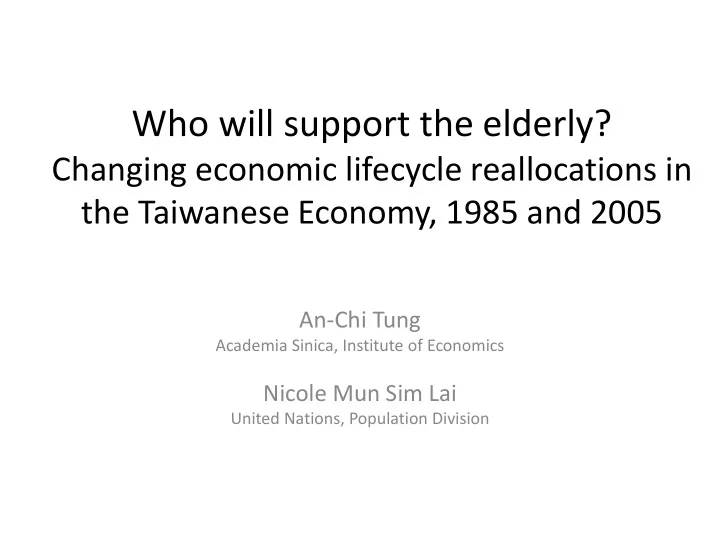

Who will support the elderly? Changing economic lifecycle reallocations in the Taiwanese Economy, 1985 and 2005 An-Chi Tung Academia Sinica, Institute of Economics Nicole Mun Sim Lai United Nations, Population Division
Introduction • Literature shows “raising children for old-age security” in the Taiwanese economy • With enormous social, economic and demographic change, informal system may weaken. • Who are supporting elderly now, what should public sector do, what should people prepare for old-age?
Objective • To examine the changing pattern of old-age financing between 1985 and 2005.
Data • Family Income and Expenditure Survey 1985, 2005 • National Income Accounts 1985, 2005 • Public statistical reports (National Health Insurance, number of student enrolled, public expenditures by student level, etc.)
Lifecycle Consumption Pattern Figure 1: Per capita consumption by age, 1985 and 2005 Consumption pattern similar to most developing countries Drop in consumption during old-age Contrary to consumption- smoothing model Overtime, old-age consumption increases
How much is health consumption overtime? Figure 2: Per Capita Health Consumption by Age, 1985 2005 Health consumption for elderly increased tremendously Health consumption is mainly provided by National Health Insurance
How is old-age consumption being finance? Figure 3: Finance of Consumption for Older Persons 65+ 1985 1. Intra-household transfers 2. Labor Income 3. Asset Reallocations 2005 1. Asset Reallocations 2. Familial transfers 3. Public transfers
Verifying with other data Figure 4 Sources of income for older persons aged 65+, 1986-2009 100% per capita income (relative to 15-64 Results are similar with 90% some differences that 80% are due to variable 70% labor income or definition. pension 60% children or Eg. Familial transfers, relatives 50% property income Property income 40% public transfers 30% 20% 10% 0% 1986 1989 1991 1993 1996 1999 2002 2005 2009 Source: tabulated from the Survey od Elderly Condition, Ministry of Interior
1. Getting less from labor income 2. Increasing self-reliance on old-age 3. Rising role of public transfers 4. Lesser reliance on family
1. Getting Less from Labor Income Figure 4. Per Capita Consumption and Labor Income by Age, 1985 & 2005 2005 labor income starts later at young but decline earlier at old age
Trend: LFPR↓ Unemployment rate↑ Table 1 Labor Force Participation Rate and Unemployment Rate by Year and Age Labour Force Participation Rate Year age 15+ age 15-19 age 20-29 age 30-39 age 40-49 age 50-59 age 60-64 age 65+ 1985 59.49% 31.39% 66.63% 73.36% 72.43% 61.39% 40.75% 9.75% 1995 58.71% 18.38% 69.14% 77.11% 75.73% 60.64% 40.95% 9.79% 2005 57.78% 9.20% 64.23% 79.74% 75.20% 56.72% 31.78% 7.23% 2011 58.07% 7.94% 63.83% 80.91% 76.61% 56.87% 31.70% 8.08% Unemployment Rate Year age 15+ age 15-19 age 20-29 age 30-39 age 40-49 age 50-59 age 60-64 age 65+ 1985 2.90% 8.19% 5.08% 1.58% 1.10% 1.17% 0.84% -- -- 1995 1.79% 5.88% 3.73% 1.18% 0.79% 0.59% 0.34% -- 2005 4.13% 13.89% 7.99% 3.35% 2.93% 2.89% 1.98% -- 2011 5.21% 12.00% 10.92% 4.90% 3.99% 3.43% 1.64%
2. Increasing self-reliance on old age Figure 6. Per Capita Asset Reallocations by Age, 1985 & 2005 Elders are not dis-saving but saving, which is at odd with lifecycle standard model Accumulating wealth to leave bequests, to compensate descendants with tax burdens?
3. Rising role of public transfer programs Figure 7. Per capita public transfers by age, 1985 & 2005 Old Age Allowance Program (1993);USD90-170; low-income elderly; 70% of 65+; 1/4 cons National Health Insurance (1995) Labor Insurance (1958); 50% workforce; Contribution 6.5% (employee 20%, employers 70%, gov 10%); lump-sum benefits
4. Lesser reliance on family Figure 8. Per capita net intra-household transfers by age, 1985 & 2005 Elderly are still net receivers Elderly living independently 1988: 25% 2009: 42% Elderly as household heads 1985: 5% 2005: 16% Will Taiwan become like Japan in terms of familial transfers trend?
Conclusions • Elderly total consumption increases • Old-age financing shifted from the family to the public and from labor income to asset income • How will financing be in the future?
Thank you
Recommend
More recommend